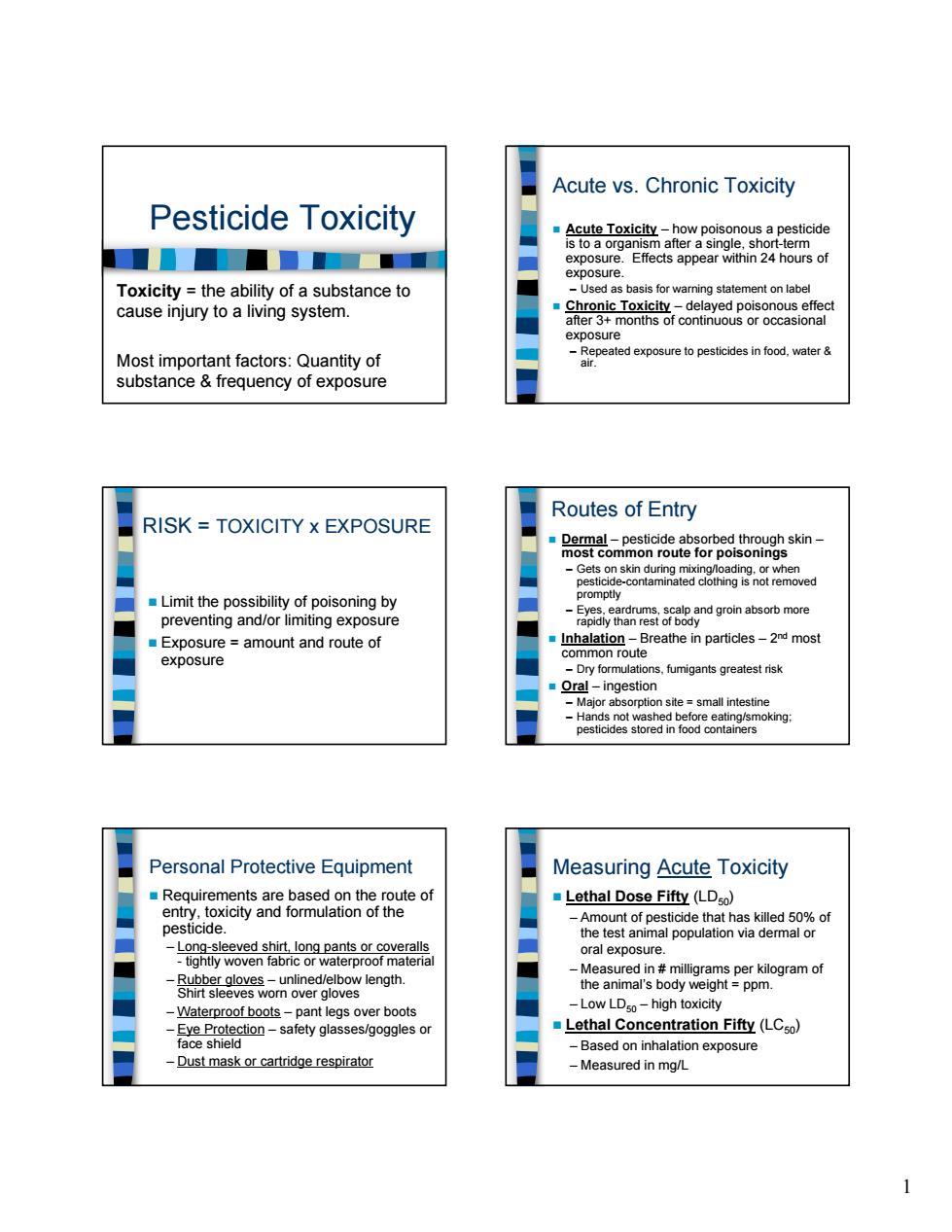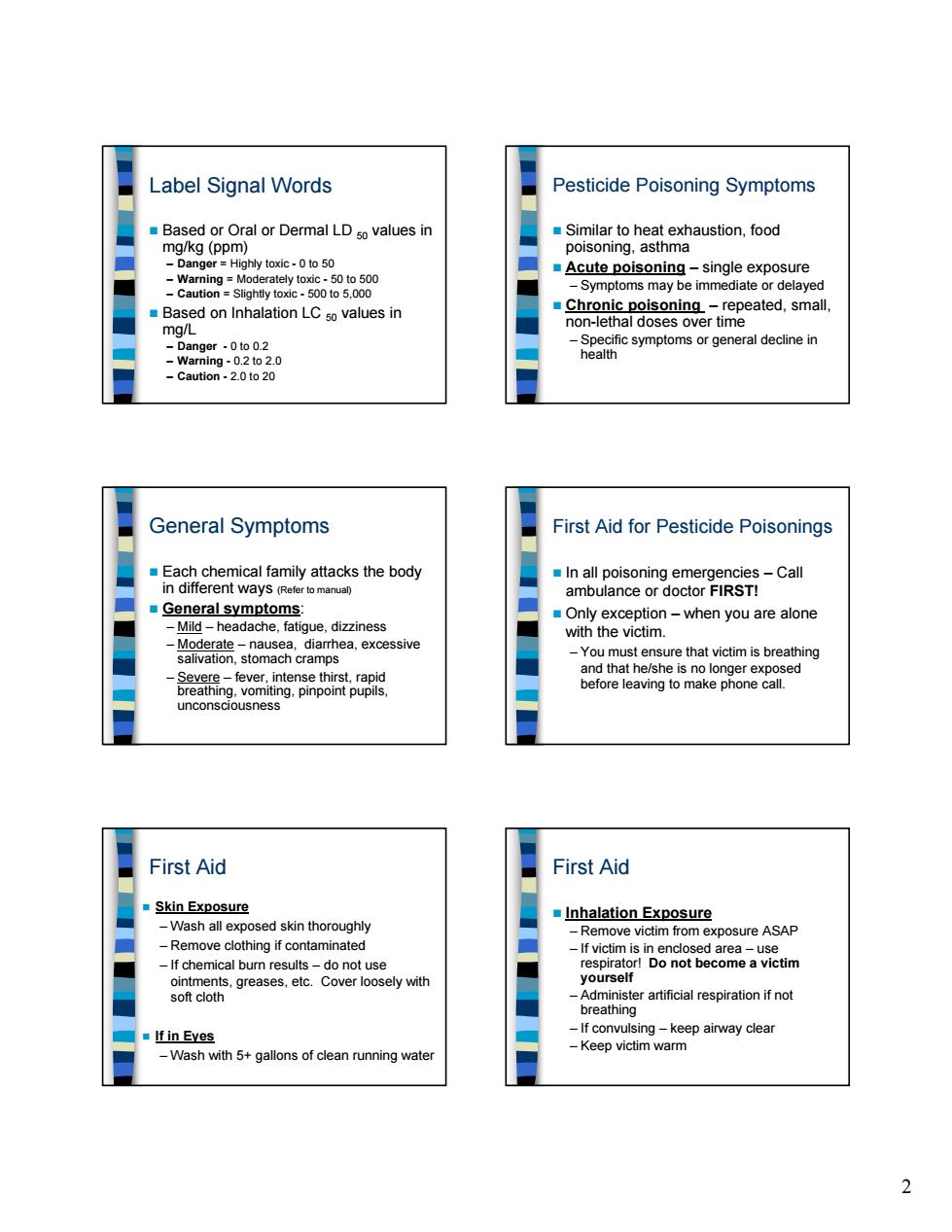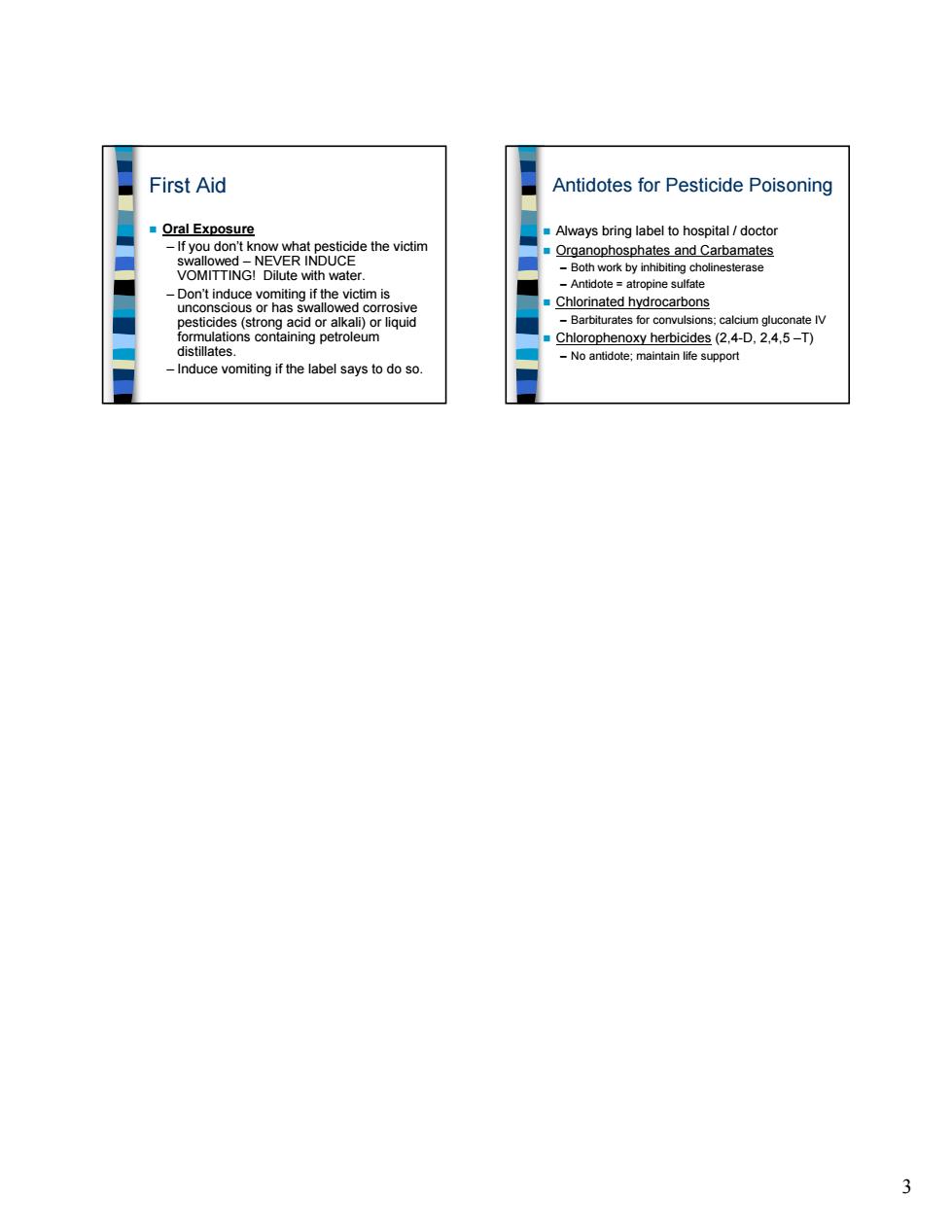
Acute vs.Chronic Toxicity Pesticide Toxicity ■■■■ exposure.Effects appear within 24 hours of exposure Toxicity the ability of a substance to cause injury to a living system. exposure Most important factors:Quantity of ppesticdesin od water substance frequency of exposure Routes of Entry RISK TOXICITY x EXPOSURE "R器268ee胎i8pobn23skn -escoaeatonihmeda8oaggeteheoved Limit the possibility of poisoning by preventing and/or limiting exposure 一s8yaghregndgronabsowbmore Exposure=amount and route of Inhalation-Breathe in particles-2nd most exposure common route -Dry formulations.fumigants greatest risk ■Oral-ingestion Personal Protective Equipment Measuring Acute Toxicity Requirements are based on the route of Lethal Dose Fifty(LD0) entry,toxicity and formulation of the pesticide. oral exposure Ss%28eSanoegeengh ppm -Waterproof boots-pant legs over boots -Low LDso-high toxicity 器n0-aey0esa9o9eso Lethal Concentration Fifty(LCso) -Based on inhalation exposure Dust mask or cartridge respirator Measured in mg/L 1
1 Pesticide Toxicity Toxicity = the ability of a substance to cause injury to a living system. Most important factors: Quantity of substance & frequency of exposure Acute vs. Chronic Toxicity Acute Toxicity – how poisonous a pesticide is to a organism after a single, short-term exposure. Effects appear within 24 hours of exposure. – Used as basis for warning statement on label Chronic Toxicity – delayed poisonous effect after 3+ months of continuous or occasional exposure – Repeated exposure to pesticides in food, water & air. RISK = TOXICITY x EXPOSURE Limit the possibility of poisoning by preventing and/or limiting exposure Exposure = amount and route of exposure Routes of Entry Dermal – pesticide absorbed through skin – most common route for poisonings – Gets on skin during mixing/loading, or when pesticide-contaminated clothing is not removed promptly – Eyes, eardrums, scalp and groin absorb more rapidly than rest of body Inhalation – Breathe in particles – 2nd most common route – Dry formulations, fumigants greatest risk Oral – ingestion – Major absorption site = small intestine – Hands not washed before eating/smoking; pesticides stored in food containers Personal Protective Equipment Requirements are based on the route of entry, toxicity and formulation of the pesticide. – Long-sleeved shirt, long pants or coveralls - tightly woven fabric or waterproof material – Rubber gloves – unlined/elbow length. Shirt sleeves worn over gloves – Waterproof boots – pant legs over boots – Eye Protection – safety glasses/goggles or face shield – Dust mask or cartridge respirator Measuring Acute Toxicity Lethal Dose Fifty (LD50) – Amount of pesticide that has killed 50% of the test animal population via dermal or oral exposure. – Measured in # milligrams per kilogram of the animal’s body weight = ppm. – Low LD50 – high toxicity Lethal Concentration Fifty (LC50) – Based on inhalation exposure – Measured in mg/L

abel Signal Words Pesticide Poisoning Symptoms Based or Oral or Dermal LDs values in g/kg (ppm) ■ ■ Based on Inhalation LC so values in eral decline in General Symptoms First Aid for Pesticide Poisonings 5agcheeamicayamyaacshetbody In all poiso ora0dorRs-cal ■General symptoms: ■ Mheadache.fatigue. -when you are alone salivation,stomach cramps a,exces -You must ensure that victim is breathing First Aid First Aid Skin Exposure Inhalation Exposure Remove clo -Remove victim from exposure ASAP es greases.etc ister artificial respiration ifno If in Eyes -If convulsing-keep airway clear Keep victim warm -Wash with 5+gallons of clean running wate 2
2 Label Signal Words Based or Oral or Dermal LD 50 values in mg/kg (ppm) – Danger = Highly toxic - 0 to 50 – Warning = Moderately toxic - 50 to 500 – Caution = Slightly toxic - 500 to 5,000 Based on Inhalation LC 50 values in mg/L – Danger - 0 to 0.2 – Warning - 0.2 to 2.0 – Caution - 2.0 to 20 Pesticide Poisoning Symptoms Similar to heat exhaustion, food poisoning, asthma Acute poisoning – single exposure – Symptoms may be immediate or delayed Chronic poisoning – repeated, small, non-lethal doses over time – Specific symptoms or general decline in health General Symptoms Each chemical family attacks the body in different ways (Refer to manual) General symptoms: – Mild – headache, fatigue, dizziness – Moderate – nausea, diarrhea, excessive salivation, stomach cramps – Severe – fever, intense thirst, rapid breathing, vomiting, pinpoint pupils, unconsciousness First Aid for Pesticide Poisonings In all poisoning emergencies – Call ambulance or doctor FIRST! Only exception – when you are alone with the victim. – You must ensure that victim is breathing and that he/she is no longer exposed before leaving to make phone call. First Aid Skin Exposure – Wash all exposed skin thoroughly – Remove clothing if contaminated – If chemical burn results – do not use ointments, greases, etc. Cover loosely with soft cloth If in Eyes – Wash with 5+ gallons of clean running water First Aid Inhalation Exposure – Remove victim from exposure ASAP – If victim is in enclosed area – use respirator! Do not become a victim yourself – Administer artificial respiration if not breathing – If convulsing – keep airway clear – Keep victim warm

First Aid Antidotes for Pesticide Poisoning 9 ral Exposure Always bring label to hospital/doctor you aor ■ Organophosphates and Carbamates esterase -Don't ind he victim is Chlorinated hydrocarbons esticides ng aci 402A miting if the labelsaystodos 3
3 First Aid Oral Exposure – If you don’t know what pesticide the victim swallowed – NEVER INDUCE VOMITTING! Dilute with water. – Don’t induce vomiting if the victim is unconscious or has swallowed corrosive pesticides (strong acid or alkali) or liquid formulations containing petroleum distillates. – Induce vomiting if the label says to do so. Antidotes for Pesticide Poisoning Always bring label to hospital / doctor Organophosphates and Carbamates – Both work by inhibiting cholinesterase – Antidote = atropine sulfate Chlorinated hydrocarbons – Barbiturates for convulsions; calcium gluconate IV Chlorophenoxy herbicides (2,4-D, 2,4,5 –T) – No antidote; maintain life support